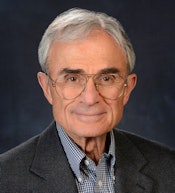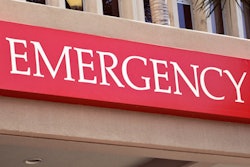
Bucking an overall downward trend in utilization of advanced imaging services, emergency departments (EDs) are still seeing growth in imaging, especially in CT use, which has tripled over the past decade, according to a new article in the Journal of the American College of Radiology.
Researchers from Thomas Jefferson University (TJU) looked at emergency department utilization of imaging tests from 2002 through 2012, parsing Medicare Part B data to determine the frequency of imaging exams by modality. They found that x-ray and CT were the most widely used modalities in the ED, and both rose over the decade, though x-ray's ascent has been slower: Radiography use rose by more than one-fourth, but CT utilization nearly tripled (JACR, November 2014, Vol. 11:11, pp. 1044-1047).
"Imaging rates in every modality nationwide at all venues where imaging is done have flattened out or started to come down," lead author Dr. David C. Levin, professor emeritus of radiology at TJU, told AuntMinnie.com. "The emergency department is the only place where imaging rates have continued to go up, and this paper shows they're going up in every modality, especially plain films and CT."
Rising imaging use soon halted
At the turn of the 21st century, imaging was the fastest-growing segment among all physician services. But the growth alarmed policymakers and payors, and within a few years various techniques were adopted to control utilization.
 Dr. David C. Levin from Thomas Jefferson University.
Dr. David C. Levin from Thomas Jefferson University.Steps to curb imaging ran the gamut and included reimbursement cuts, code bundling and higher deductibles, co-payments for patients, and computerized decision support, Levin and colleagues wrote.
On the whole, the effort has been a success. Growth in advanced imaging has all but stopped or has even reversed, the authors wrote. But imaging occurs in four kinds of service venues: hospital outpatient facilities, private offices, hospital inpatient facilities, and emergency departments. And little research has been done to ascertain precisely where the changes in imaging rates have occurred.
A previous study did show, however, that imaging rates were rising in emergency departments through 2008.
"The feeling among some radiologists at present is that although overall imaging utilization is flat or showing a decline, its use in the ED may be continuing to increase," Levin and colleagues Dr. Vijay Rao and Laurence Parker, PhD, wrote. "In this study, we extend the review of ED imaging trends through 2012 and attempt to determine if this impression is correct."
Data came from Medicare Part B Physician/Supplier Procedure Summary Master Files from 2002 through 2012. The files cover all services to 36.9 million beneficiaries in the Medicare fee-for-service population, but not the nearly 14,000 in Medicare Advantage plans.
Exam volume, location, place of service, and specialty provider were all included; the researchers grouped every code by modality for plain radiography, CT, noncardiac ultrasound, MRI, and nuclear medicine. Interventional codes were excluded. Rates were calculated per 1,000 beneficiaries, and ED trends were compared with non-ED trends.
The researchers found that x-ray use rose slowly and steadily between 2002 and the end of 2012, from 248.7 exams per 1,000 beneficiaries to 320 exams per 1,000.
Over the same decade, CT use rose rapidly every year except for a one-year decline in 2011, resuming its rise in 2012. During the entire study period, CT rose from 57.2 exams per 1,000 beneficiaries to 147.9 exams in 2012 -- growth of 158%.
"In 2011, instead of going up, [CT] went down," Levin said. "That was an artifact of code bundling in CT of the abdomen and pelvis."
Even ultrasound use increased over the decade, though it rose considerably less than x-ray and CT, increasing from 9.5 exams per 1,000 beneficiaries in 2002 to 21.0 in 2012, for a growth rate of 121%. Ultrasound was not burdened by code bundling.
Finally, the utilization rate for nuclear medicine fell from 2.8 exams per 1,000 beneficiaries to 2.1 in 2012, a drop of 25%, largely due to code bundling in myocardial perfusion imaging.
| ED imaging exam rates per 1,000 Medicare beneficiaries | ||
| Exam | 2002 rate per 1,000 | 2012 rate per 1,000 |
| CT | 57.2 | 147.9 |
| Plain radiography | 248.7 | 320.0 |
| Ultrasound | 9.5 | 21.0 |
| MRI | 1.4 | 5.1 |
| Nuclear medicine | 2.8 | 2.1 |
Why the spike in CT use?
"The ED has become very crowded and busy; I think the ED doctors are under a lot of pressure to turn patients around, and they know CT is a good tool to make accurate diagnoses and make a disposition of the case to discharge the patient when they want a definitive diagnosis," Levin said. "I don't fault them for that -- they're under the gun."
In cardiac imaging, for example, multiple studies have shown that a negative coronary CT angiography (CCTA) exam means that chest pain patients can be safely discharged if they do not have evidence of significant stenosis.
"I think those studies are right on the mark," Levin said. "Every chest pain patient who walks in where there's any kind of clinical suspicion for that should immediately go for CCTA right off the bat," he said. "If they get a CT scan, the ED physician will know immediately if they have something serious."
The scan length can, of course, be extended to a triple rule-out exam when there is also suspicion of aortic dissection or pulmonary embolism, and it will reveal any other cause of chest pain that might be present, such as pleural effusion or pneumothorax, Levin said.
What about overuse?
Medicare data show that in 2012, 18.4 million imaging studies were performed in emergency departments, constituting 14% of all Medicare fee-for service imaging, the authors wrote.
It is concerning that imaging rates continue to grow, and the results suggest that radiologists should work more closely with their ED colleagues to exert tighter control over imaging utilization.
The solutions include more diligent application of clinical rules for imaging, such as the Wells criteria for suspected pulmonary embolism, or the Canadian C-spine rule for cervical spine trauma, the authors wrote. ED physicians should be better educated about American College of Radiology (ACR) appropriateness criteria, and cooperation between radiologists and ED physicians should be better tailored to emergency or trauma situations.
Use of computerized clinical decision support will also be helpful, along with greater familiarity among radiologists and ED physicians with exams that are potentially unnecessary or overused according to the Choosing Wisely initiative.
But while Levin said he is sure there are instances when CT is overused in the ED, he doesn't think of it as a global problem.
"I think, in general, recognizing the fact that ED docs have been really under the gun, they've been swamped with more and more patients, and there's always the fear of malpractice liability lurking in the shadows, we have to be sympathetic," Levin said.
In any case, the 2013 data will be out within a month, and it will be interesting to see if current trends continue, he said.




















